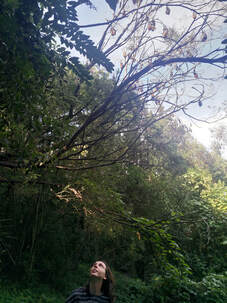Eliane McCarthy
- MRes Student, Lab of Animal Ecology, Hawkesbury Institute for the Environment, University of Western Sydney
- Topic: Remote sensing of Australian flying-fox roosts
- Research Umbrella: Flying-fox movement ecology
- Supervisors: A/Prof Justin Welbergen, Dr John Martin, A/Prof Matthias Boer
- Contact: Eliane McCarthy

Bio:
I completed a Bachelor of Science, majoring in Biology in 2016. During my studies I participated in a project examining the factors affecting breeding success in the grey-headed flying-fox and have been fascinated by flying-foxes ever since.
I volunteered as a lab assistant for Honours and PhD students in lab and field studies on flying-foxes, other mammals and birds at the University of Sydney and the Royal Botanic Gardens, Sydney.
After working in bush regeneration for a year, I began a Master of Research (MRes) with the Animal Ecology Lab at Western Sydney University in 2018. In the Autumn Semester of 2018-2019 I completed a semester abroad at Utrecht University in the Netherlands to study advanced techniques in statistics, Geographical Information Systems (GIS) and remote sensing.
I completed a Bachelor of Science, majoring in Biology in 2016. During my studies I participated in a project examining the factors affecting breeding success in the grey-headed flying-fox and have been fascinated by flying-foxes ever since.
I volunteered as a lab assistant for Honours and PhD students in lab and field studies on flying-foxes, other mammals and birds at the University of Sydney and the Royal Botanic Gardens, Sydney.
After working in bush regeneration for a year, I began a Master of Research (MRes) with the Animal Ecology Lab at Western Sydney University in 2018. In the Autumn Semester of 2018-2019 I completed a semester abroad at Utrecht University in the Netherlands to study advanced techniques in statistics, Geographical Information Systems (GIS) and remote sensing.
|
Research:
Australian flying-foxes roost among trees in groups of a few hundred to many thousands of individuals during the day. At night they fly long distances to forage on pollen, nectar and fruit. Flying-foxes are of important conservation and management concern, but robust methods for estimating their population sizes are lacking. Currently, flying-fox population sizes are estimated by human-conducted ground counts of individuals at roosts, or by fly-out counts as bats emerge from their roost at dusk. These counting methods are subject to human error, but it is unclear how much this contributes to the uncertainty around flying-fox population estimates. My research aims to address this issue and help develop more accurate methods for estimating and monitoring flying-fox populations. |
|
The first part of my project will see me developing and testing a new method for generating more accurate population estimates of flying-fox colonies, using thermal drones. I will use computer vision and machine learning classification techniques to count flying-foxes semi-automatically.
The second part of my project will involve comparing population estimates derived from aerial thermal imagery to estimates derived from traditional ground counting methods. This work will help to calibrate and improve current counting efforts and generate a better understanding of the spatiotemporal distribution of flying-foxes across the Australian landscape.
The second part of my project will involve comparing population estimates derived from aerial thermal imagery to estimates derived from traditional ground counting methods. This work will help to calibrate and improve current counting efforts and generate a better understanding of the spatiotemporal distribution of flying-foxes across the Australian landscape.
Publications
MCCARTHY, E. D., MARTIN, J. M., BOER, M. M. & WELBERGEN (2022). Ground-based counting methods underestimate true numbers of a threatened colonial mammal: an evaluation using drone-based thermal surveys as a reference. Wildlife Research, doi: 10.1071/WR21120
MCCARTHY, E. D., MARTIN, J. M., BOER, M. M. & WELBERGEN (2021). Drone-based thermal remote sensing provides an effective new tool for monitoring the abundance of roosting fruit bats. Remote Sensing in Ecology and Conservation.

